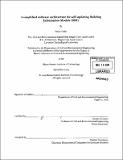| dc.contributor.advisor | Jerome J. Connor. | en_US |
| dc.contributor.author | Fuller, Pierre (Pierre Henri) | en_US |
| dc.contributor.other | Massachusetts Institute of Technology. Dept. of Civil and Environmental Engineering. | en_US |
| dc.date.accessioned | 2010-05-25T20:54:57Z | |
| dc.date.available | 2010-05-25T20:54:57Z | |
| dc.date.copyright | 2009 | en_US |
| dc.date.issued | 2009 | en_US |
| dc.identifier.uri | http://hdl.handle.net/1721.1/55155 | |
| dc.description | Thesis (S.M.)--Massachusetts Institute of Technology, Dept. of Civil and Environmental Engineering, 2009. | en_US |
| dc.description | Cataloged from PDF version of thesis. | en_US |
| dc.description | Includes bibliographical references (p. 61-63). | en_US |
| dc.description.abstract | Building Information Modeling (BIM) is an emerging software technology that is revolutionizing the architecture, engineering, and construction (A/E/C) industry. BIM technology employs "object-based 3D models-containing the physical and functional characteristics of a facility-that serve as a repository for lifecycle information in an open, interoperable format" [1]. The major difference between BIM and Computer-Aided Design/Drafting (CADD) is that the former includes geometry and a plethora of building information while the latter includes only geometry. BIM utilization in the AEC industry has increased due to 1) BIM tools increasing productivity in design tasks; 2) the increasing number of private and government agencies that have instituted BIM requirements; 3) the pervasive use of computer analysis and simulations models; 4) the benefits of BIM as lifecycle management tool. Current literature shows trends of a transition from a "passive"-static model-based-approach to an "active"-dynamic model-based-approach. The active approach requires the integration of BIM with sensors to create "self-updating" building models. Previous research introduces the concept of a self-updating building model ([2], [31, [41). These systems involve complex software architecture and may perpetuate the problem of software interoperability. This thesis explores the following question: May a similar system be created to synthesize dynamic sensor data while improving upon previous research and simplifying the software architecture? The author describes a prototype system, called LiveBuild, which integrates commercial BIM software with other off-the-shelf software components to create a self-updating building model. LiveBuild is the first self-updating building model that operates as an extension to existing commercial BIM software. Therefore, the transition from static to active building models is as simple as installing a plug-in. LiveBuild may serve as the basis for future research in self-updating building by providing simplified system that is well integrated with state-of-the art commercial design software. Likewise, the prototype is applicable for professional practice by allowing firms to use their existing BIM software to perform "pilot projects" with self-updating technology. The current prototype supports an interface with single commercial BIM software (Autodesk Revit 2009) product however future prototypes may extend both the functions and interfaces for other BIM software. | en_US |
| dc.description.statementofresponsibility | by Pierre Fuller. | en_US |
| dc.format.extent | 63 p. | en_US |
| dc.language.iso | eng | en_US |
| dc.publisher | Massachusetts Institute of Technology | en_US |
| dc.rights | M.I.T. theses are protected by
copyright. They may be viewed from this source for any purpose, but
reproduction or distribution in any format is prohibited without written
permission. See provided URL for inquiries about permission. | en_US |
| dc.rights.uri | http://dspace.mit.edu/handle/1721.1/7582 | en_US |
| dc.subject | Civil and Environmental Engineering. | en_US |
| dc.title | A simplified software architecture for self-updating Building Information Models (BIM) | en_US |
| dc.type | Thesis | en_US |
| dc.description.degree | S.M. | en_US |
| dc.contributor.department | Massachusetts Institute of Technology. Department of Civil and Environmental Engineering | |
| dc.identifier.oclc | 607535407 | en_US |
